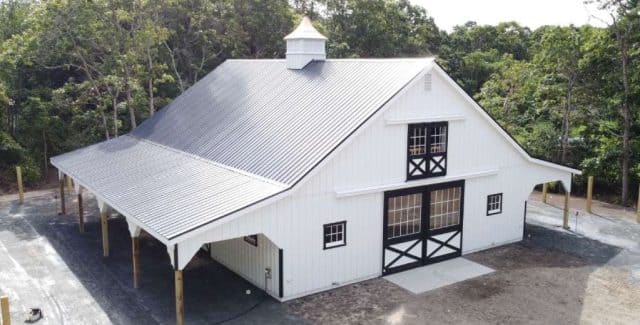When it comes to barn construction, selecting the right roof style is crucial. The roof not only provides protection against the elements but also significantly impacts the overall aesthetics of the barn. In this comprehensive guide, we will explore the top 10 barn roof styles that offer the perfect blend of durability and visual appeal. Whether you are building a new barn or renovating an existing one, these roof styles will help you make an informed decision.
1. Gable Roof
The gable roof is one of the most popular and traditional barn roof styles. Known for its simplicity and effectiveness, the gable roof features two sloping sides that form a triangular shape. This design allows for excellent water and snow runoff, making it ideal for regions with heavy precipitation. Additionally, the steep pitch provides ample attic space, which can be used for storage.
2. Gambrel Roof
The gambrel roof, often associated with classic American barns, offers a distinct and charming look. This roof style has two slopes on each side: a steep lower slope and a shallower upper slope. The gambrel design maximizes the usable space within the barn, creating a spacious loft area. It is particularly well-suited for barns used as storage facilities or living spaces.
3. Hip Roof
A hip roof features four sloping sides of equal length, meeting at a ridge. This design is highly stable and resistant to high winds, making it an excellent choice for barns in hurricane-prone areas. The hip roof also offers a symmetrical appearance, adding to the barn’s overall aesthetic appeal. Its durability and stability make it a reliable option for long-term use.
4. Monitor Roof
The monitor roof is a unique and functional style that includes a raised center section with its own gabled roof. This design allows for additional windows or ventilation openings, improving air circulation and natural light within the barn. The monitor roof is ideal for barns housing livestock, as it helps maintain a comfortable and healthy environment.
5. Saltbox Roof
The saltbox roof is characterized by its asymmetrical design, with one side being longer than the other. This roof style was traditionally used in colonial architecture and is known for its distinctive appearance. The saltbox roof provides excellent protection against wind and rain, making it a durable choice for barns in areas with harsh weather conditions. Its unique shape also adds a touch of historical charm.
6. Shed Roof
A shed roof is a simple, single-slope roof that is easy to construct and maintain. This style is often used for smaller barns or lean-to structures. The shed roof is cost-effective and allows for efficient water drainage. Its minimalist design can be enhanced with modern materials and finishes to create a sleek, contemporary look.
7. Dutch Roof
The Dutch roof, also known as a Dutch gable roof, combines the features of a gable and hip roof. It includes a small gable at the top of a hipped roof, providing additional space and ventilation. This roof style offers a unique aesthetic and increased functionality. The Dutch roof is a versatile option that suits various barn designs and purposes.
8. Clerestory Roof
A clerestory roof features a row of windows along the top of the roofline, allowing natural light to flood the interior of the barn. This design is both practical and visually appealing, creating a bright and airy atmosphere. The clerestory roof is particularly beneficial for barns used as workshops or studios, where ample daylight is essential.
9. Skillion Roof
The skillion roof, also known as a lean-to roof, consists of a single, sloping plane. This style is straightforward to construct and provides effective drainage. The skillion roof is often used for extensions or additional structures attached to the main barn. Its modern appearance and simplicity make it a popular choice for contemporary barn designs.
10. Arched Roof
The arched roof is a distinctive and elegant option that features a curved design. This roof style offers excellent durability and resistance to wind and snow loads. The arched roof creates a spacious interior with a unique architectural appeal. It is ideal for barns used as event spaces or agricultural buildings where aesthetics and functionality are equally important.
Choosing the Right Roof Style
When selecting a barn roof style, it is essential to consider factors such as climate, intended use, and architectural preferences. Each of these top 10 barn roof styles offers unique benefits in terms of durability and aesthetics. By carefully evaluating your needs and preferences, you can choose a roof style that enhances the functionality and visual appeal of your barn.


